

Sascha Herrmann
Glimmer
23.05 – 03.07.21

Glimmer
Magnesium burns under water at 3000° Celsius. The exothermic reaction splits the molecules into their components hydrogen and oxygen. If one looked into this flame, it would result in blindness or at least in permanent damage. For his video work, "Glimmer" (2021), Sascha Herrmann filmed this reaction. Nothing was left afterwards, except a white powder, the so-called magnesia.
The video work’s screen rests on a pile of white cement, which likewise is created through burning. Rivers are dredged, silica sand is transported over long distances, and finally combusted at high temperature, and then processed into concrete, cement, and plaster. This process emits twice as much CO2 as airplane travel, before it results in a fine cohesive powder, which, mixed with water, turns into an alkaline solution. When it is hardened, it is one of the most widely used building materials in the world. Minerals are extracted and transformed. Stones are never idle.
Herrmann studied photography in Leipzig, Düsseldorf, and Brussels. The work of the artist, born in 1982, often does not look like documentary photography, sometimes it doesn’t even look like photography. And yet he says that his images are reproductive. That means at the same time that his pieces resemble experiments. They are repeatable, and their results are not predetermined. His subject is the abstraction of nature, and he asks the question how to make it more palpable. Science and photography share a bond, and once photography has been used as an instrument to obtain proof. Doubts about the absolute veracity of the image have weakened this bond, but photography has retained a certain magic. It comes into being in a black box, and one of its idiosyncratic features is that you cannot watch it while it is at work.
As you move through the space around the video work, a deep sound can be heard. You might think of constructed music with a minimalist arc. What at first seems like an ebb and flow of melody is actually a continuous noise. The changes are contingent and depend entirely on the movements of the viewers: sound, not music. There is quiet in some spots, whereas in other corners it is almost unbearably loud. The sound is a 70 hertz sine wave, which leads to a phase cancellation between the two speakers. The noise—which spreads wave-like—issues in a shifted way, and in some spots valley and crest coincide. They cancel each other out, and create a zero point. It results in silence. There are three main forces which influence the formation of minerals: pressure, temperature, humidity. Those are also the forces that shape clouds. Are Herrmann’s images concealed cloud studies after all? As above, so below, says an old precept of alchemy. It is not advisable to search the prehistory of science for explanations of the world. But its traces can surprisingly turn up in aesthetic discourse, where a system of correspondence can provide all the cohesion.
The artist describes his work as phenomenological—and phenomenology has once been defined by the French philosopher Jean-François Lytoard as knowledge about knowledge. It reveals a consciousness that only arises in relation to the world, consciousness which is even interlaced with the world (1).
There are forces that escape our perception, but photography and sound are able to render them perceptible. When it is about sound, Herrmann places his attention on friction between molecules. In the past he has worked with said hidden forces, for instance in the sound and video piece "Receive Record" (2018), which by means of a theremin interprets the sound of northern lights. Aurorae emit a sound because differently charged molecules collide in the atmosphere. Maybe the phenomenological core of his works consists in showing the continuity of these forces.
For his show "Glimmer," Herrmann directs his glance towards the mineral world. The focus—in line with the medium of photography—lies on reflection and refraction. Herrmann’s series of c-prints (2021) is the result of spectral analysis, in which different stones have been illuminated by various light sources. They all have a history, properties, and attributions. There is mica, a stone that gleams silvery, which in the Middle Ages has been sold as precious metal. Or the Iceland spar, that can polarise light—double it, that is—which is why it is used in a lot of optical applications, for example in photography. Kyanite and opal, emerald and a moonstone, they are all depicted in front of a black backdrop, and actually all these photos are all negatives. The background has been illuminated, the stones have also been spotlit from the front, and frequently they divulge their features only in light: they glow, they reflect and refract, they gleam and iridesce.
The work "Devils Hill" (2018) consists of a vitrine on a plinth. It contains a large lump of barite. Depending on the viewers’ position, the glass is opaque or transparent, because it is covered with a polarising foil. The stone—one of the heaviest minerals, this specific one weighs 15 kilograms—has been coated with a photographic emulsion, to reproduce an image of the former US listening station on Berlin’s Teufelsberg. It is monochromatic and abstract.
The heavy lump of barite is sometimes clear, sometimes it appears covered in mist, its coated surface shimmers like gelatine, it seems immaterial like a cloud. Stones and clouds are analogous entities, at least in the work of Sascha Herrmann. As paradox as it seems, both are similar in their fleetingness, and the constant change of both escapes our perception. The meteorological question when one cloud ends and a new one comes into being turns into a philosophical one. With stones this process lasts many millennia. It wouldn’t even be outlandish to understand clouds as very large mineral systems. Very often volcanic ash or stone particles cling to aerosols, and they are thus transported across continents. Herrmann captures the fleetingness of the mineral world—that is so closely related to clouds.
- Philipp Hindahl
(1) Jean-François Lyotard, La phénoménologie, Paris 2007, 3 and 6.
Exhibtion Views
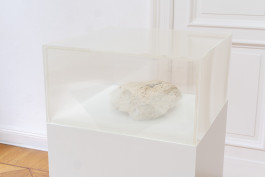
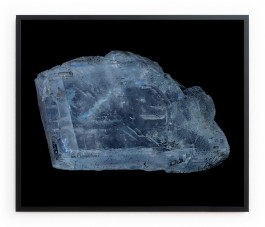

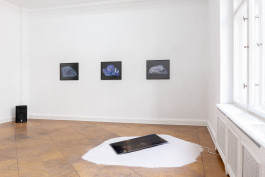

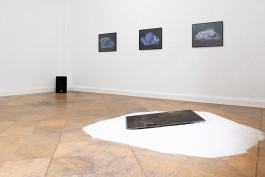


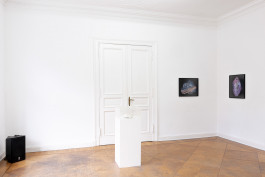
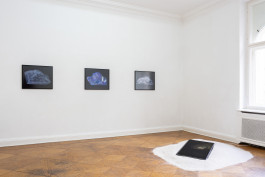
Sascha Herrmann
Glimmer
23.05 – 03.07.21

Glimmer
Magnesium burns under water at 3000° Celsius. The exothermic reaction splits the molecules into their components hydrogen and oxygen. If one looked into this flame, it would result in blindness or at least in permanent damage. For his video work, "Glimmer" (2021), Sascha Herrmann filmed this reaction. Nothing was left afterwards, except a white powder, the so-called magnesia.
The video work’s screen rests on a pile of white cement, which likewise is created through burning. Rivers are dredged, silica sand is transported over long distances, and finally combusted at high temperature, and then processed into concrete, cement, and plaster. This process emits twice as much CO2 as airplane travel, before it results in a fine cohesive powder, which, mixed with water, turns into an alkaline solution. When it is hardened, it is one of the most widely used building materials in the world. Minerals are extracted and transformed. Stones are never idle.
Herrmann studied photography in Leipzig, Düsseldorf, and Brussels. The work of the artist, born in 1982, often does not look like documentary photography, sometimes it doesn’t even look like photography. And yet he says that his images are reproductive. That means at the same time that his pieces resemble experiments. They are repeatable, and their results are not predetermined. His subject is the abstraction of nature, and he asks the question how to make it more palpable. Science and photography share a bond, and once photography has been used as an instrument to obtain proof. Doubts about the absolute veracity of the image have weakened this bond, but photography has retained a certain magic. It comes into being in a black box, and one of its idiosyncratic features is that you cannot watch it while it is at work.
As you move through the space around the video work, a deep sound can be heard. You might think of constructed music with a minimalist arc. What at first seems like an ebb and flow of melody is actually a continuous noise. The changes are contingent and depend entirely on the movements of the viewers: sound, not music. There is quiet in some spots, whereas in other corners it is almost unbearably loud. The sound is a 70 hertz sine wave, which leads to a phase cancellation between the two speakers. The noise—which spreads wave-like—issues in a shifted way, and in some spots valley and crest coincide. They cancel each other out, and create a zero point. It results in silence. There are three main forces which influence the formation of minerals: pressure, temperature, humidity. Those are also the forces that shape clouds. Are Herrmann’s images concealed cloud studies after all? As above, so below, says an old precept of alchemy. It is not advisable to search the prehistory of science for explanations of the world. But its traces can surprisingly turn up in aesthetic discourse, where a system of correspondence can provide all the cohesion.
The artist describes his work as phenomenological—and phenomenology has once been defined by the French philosopher Jean-François Lytoard as knowledge about knowledge. It reveals a consciousness that only arises in relation to the world, consciousness which is even interlaced with the world (1).
There are forces that escape our perception, but photography and sound are able to render them perceptible. When it is about sound, Herrmann places his attention on friction between molecules. In the past he has worked with said hidden forces, for instance in the sound and video piece "Receive Record" (2018), which by means of a theremin interprets the sound of northern lights. Aurorae emit a sound because differently charged molecules collide in the atmosphere. Maybe the phenomenological core of his works consists in showing the continuity of these forces.
For his show "Glimmer," Herrmann directs his glance towards the mineral world. The focus—in line with the medium of photography—lies on reflection and refraction. Herrmann’s series of c-prints (2021) is the result of spectral analysis, in which different stones have been illuminated by various light sources. They all have a history, properties, and attributions. There is mica, a stone that gleams silvery, which in the Middle Ages has been sold as precious metal. Or the Iceland spar, that can polarise light—double it, that is—which is why it is used in a lot of optical applications, for example in photography. Kyanite and opal, emerald and a moonstone, they are all depicted in front of a black backdrop, and actually all these photos are all negatives. The background has been illuminated, the stones have also been spotlit from the front, and frequently they divulge their features only in light: they glow, they reflect and refract, they gleam and iridesce.
The work "Devils Hill" (2018) consists of a vitrine on a plinth. It contains a large lump of barite. Depending on the viewers’ position, the glass is opaque or transparent, because it is covered with a polarising foil. The stone—one of the heaviest minerals, this specific one weighs 15 kilograms—has been coated with a photographic emulsion, to reproduce an image of the former US listening station on Berlin’s Teufelsberg. It is monochromatic and abstract.
The heavy lump of barite is sometimes clear, sometimes it appears covered in mist, its coated surface shimmers like gelatine, it seems immaterial like a cloud. Stones and clouds are analogous entities, at least in the work of Sascha Herrmann. As paradox as it seems, both are similar in their fleetingness, and the constant change of both escapes our perception. The meteorological question when one cloud ends and a new one comes into being turns into a philosophical one. With stones this process lasts many millennia. It wouldn’t even be outlandish to understand clouds as very large mineral systems. Very often volcanic ash or stone particles cling to aerosols, and they are thus transported across continents. Herrmann captures the fleetingness of the mineral world—that is so closely related to clouds.
- Philipp Hindahl
(1) Jean-François Lyotard, La phénoménologie, Paris 2007, 3 and 6.
Exhibtion Views









